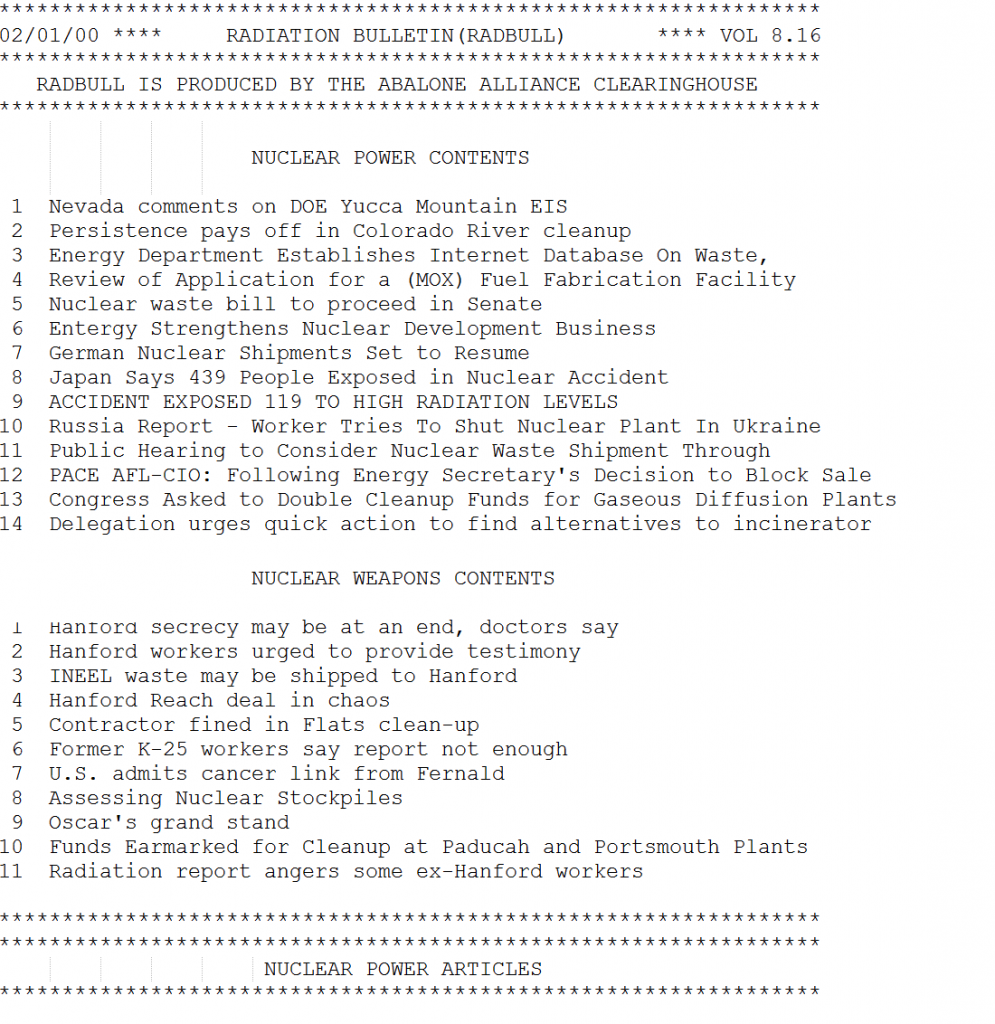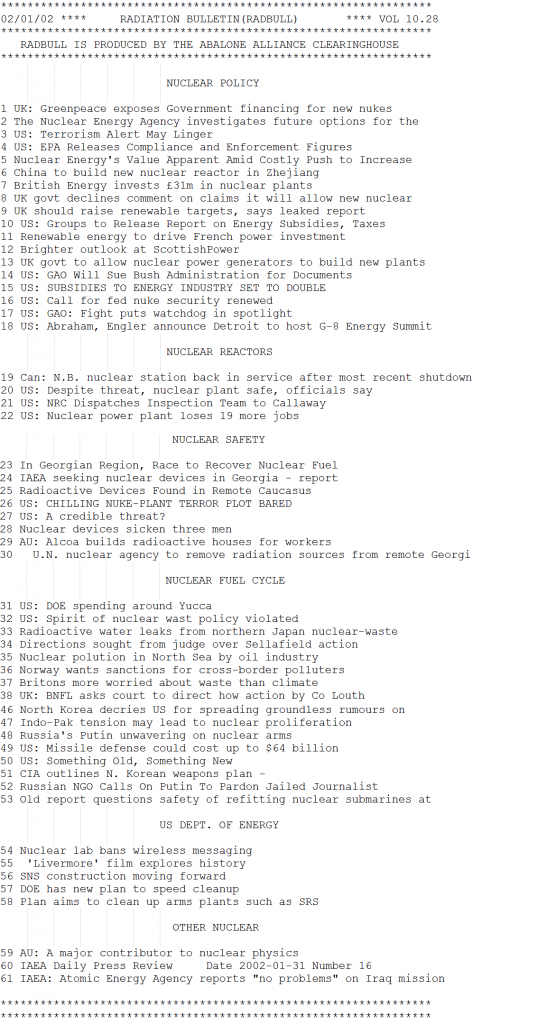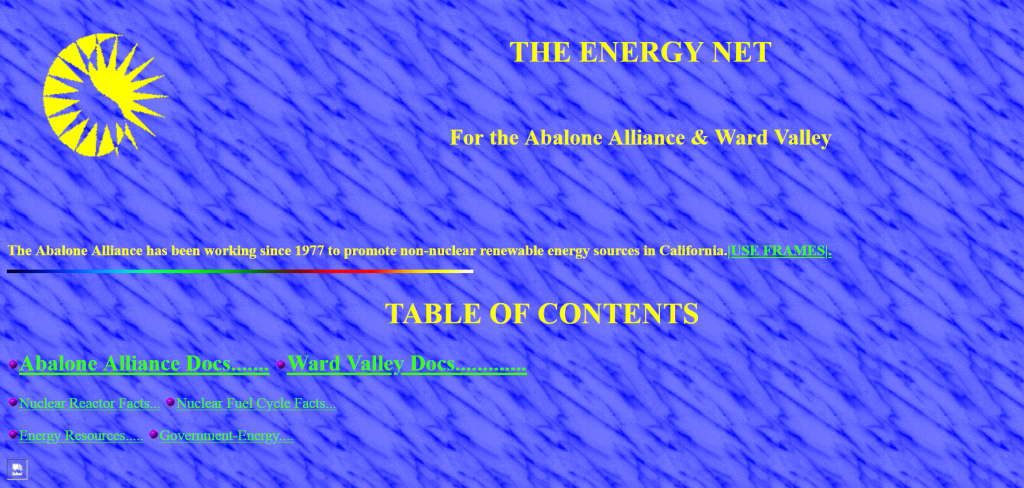Radbull actually got started in 1985, soon after the Abalone Alliance’s statewide newsletter “It’s About Times” was closed down. Don and I would produce a quarterly newsletter up until 1994 when I took it digital and daily. The Radbull is still available online and has hundreds of thousands of articles.
Back in 1994, the San Jose Mercury news made the revolutionary NewsHound wire service available for $8 a month. Prior to this access to the wire service cost $50 a month and $10 a story. Newshound meant that we could have 500 wire service stories delivered to our email on a daily basis. I wrote a computer program that allowed me to sort through these stories (mostly unusable) to produce a digital text newsletter that could then send out to subscribers all over the world. We’d become the first anti-nuclear news aggregation news service of its kind. The office had been subscribing to an online service known as PeaceNet which we started using in 1987. We also used another service called FidoNet back in the days of Bulletin Board Systems (BBS). Our BBS was first named The Energy Net back during this period, so our digital footprint pre-dated the arrival of the Internet. Back during this period we had to used a clipping service out of New York state as there was so little news about nuclear power. Between the major local daily newspapers, alternative press and PeaceNet, we were lucky to find more the 25 stories worth reprinting in Radbull a quarter!
PeaceNet and FidoNet increased these numbers slightly. Up until 1994, Radbull was a paper affair, done on recycled paper via our print coop. It was mailed out to many groups and members as the primary way of exchanging information back before the internet.
Over the years, the format slowly changed. From paper, to text, then text to HTML that would include embedded images. It never went beyond a modest niche of subscribers simply because I was too busy with the rest of my life as a building manager and caregiver. Sadly, it could have grown to be a major movement resources but was soon supplanted by the email ListServes. In this case, the first one known as NukeNet was later followed by a number of email news servers with the last major service which is still active today known as No Nukes Y’all. List Server’s were mostly supplanted by Facebook by 2011 when the Fukushima disaster exploded across the world. Prior to this, I was drawn into Cloud based publishing of news content that evolved endlessly.
From Compuserve, AOL, MySpace, Facebook, Skype, Diigo (still have a major library there) up through Twitter and Wakelets, I’ve maintained an online presence of news content. What our first Energy-Net website looked like back in 1995:
At one point, I designed a completely different news model, in hopes of organizing news content together with critical information via the growing cloud services.
The Last Radbull in 2013
Below is an evolution of the Radbull.
1989 First Page of Paper Version:

1997 December 2nd Radbull – Text & Index Only
February 2000 Index Only – Broken down into two Subjects – power & weapons:
 2002 Radbul expands its Subject groups:
2002 Radbul expands its Subject groups:
 2003 – Radbull Goes onto the Web
2003 – Radbull Goes onto the Web
 2003 February – Radbull Expands Exponentially taking on all new -non-nuclear issues.
2003 February – Radbull Expands Exponentially taking on all new -non-nuclear issues.
 2003 Radbull design that opens by subject area:
2003 Radbull design that opens by subject area:
 The final design was to bring content together in a completely radical way that broke the news down by Major subject areas with the first model being by reactor within the United States. The model was setup and is online but never distributed due to lack of interest. It was inspired by another major project that hasn’t been published called Killing Our Own – the DOE’s history of killing Americans.
The final design was to bring content together in a completely radical way that broke the news down by Major subject areas with the first model being by reactor within the United States. The model was setup and is online but never distributed due to lack of interest. It was inspired by another major project that hasn’t been published called Killing Our Own – the DOE’s history of killing Americans.




